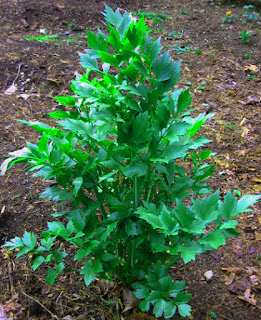In addition to writing about our experiences with plants, I like to dig deeper, yes thats a pun, and pull together more info than I alone could offer. Lovage, Levisticum officinale, for instance is a very ordinary plant for us. It’s been growing here for fifteen or so years, is a real mainstay, and I guess we kind of take it for granted. It dawned on me one day to do a post about it, and I looked it up online. The results were startling.
Lovage is uncommon. Rare is the gardener who grows it, and even though it is of European origin, it is uncommon in England. An English author muses about this, click here for the article. This author, like others, extolls virtues of the entire plant; leaves, stem, roots and seeds are edible and useful. For our own purposes we use only the leaves. They are plentiful and we pick as needed- we don't store lovage. The leaves have some similarity to celery leaves but they are are larger, thicker and a deeper green.
Lovage has a strong celery flavor, and is useful as a celery substitute either raw or cooked. The plant does not supply the shape of celery. For that you need celery. We use it for the flavor, never-minding the shape, and are generally happy about the savings. Celery is expensive and for most of the year we don’t need to buy it.
The plant is a four to six foot tall, hardy perennial and very easy to grow. A testament to the perseverance of lovage is that ours struggled in less than optimal soil conditions for years, barely surviving. The plants have improved along with the health of the soil, and they are now taller, greener, and much leafier.
It’s one of the first plants we start using right away in spring, as soon as there are several leaves and the plant can afford to lose one or two. Leaves are produced way into fall, with a heavy frost ending its growing year.
Around midsummer, when lovage goes to seed, we always hope that several new plants will get started. It’s an important plant, far from invasive, and we always want to have several to harvest from.
There are many uses for it. Finely chop a handful of leaves and add to green salad, potato or pasta salad. Chop the leaves finely or coarsely and add to stews, soups, or just about anything that is cooking in a pan on the stove. It is good with chicken, lamb, beef, eggs, potatoes, etc. And it is especially good for creating a rich soup broth. Common to us but not to many others, this is a plant we don’t want to be without. -jmm

No comments:
Post a Comment